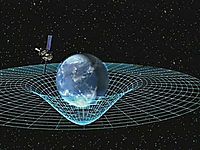
Photo from wikipedia
A general ejection theory of polymer is developed in a two- and three-dimensional space. A polymer is confined initially in a cavity and ejects spontaneously to the outer space through… Click to show full abstract
A general ejection theory of polymer is developed in a two- and three-dimensional space. A polymer is confined initially in a cavity and ejects spontaneously to the outer space through a nanopore channel without the help of any external stimulus. A reflective wall boundary is set at the pore entrance to prevent the falling of the head monomer of chain into the cavity. Three stages are distinguished in a process: (1) an entering stage, in which the head monomer enters the pore to search for a way to traverse the pore channel, (2) a main ejection stage, in which the chain body is transported from the cavity to the outer space, (3) a leaving stage, in which the tail monomer passes through and leaves the pore channel. Depending on the number of the monomers remaining in the cavity, the main ejection stage can be divided into the confined and the non-confined stages. The non-confined stage can be further split into the thermal escape and the entropic pulling stages. The Onsager’s variational principle is applied to derive the kinetics equation of ejection. The escape time is calculated from the corresponding Kramers’ escape problem. Extensive molecular dynamics simulations are then performed in a quasi two-dimensional space to verify the theory. The variation of the ejection speed is carefully examined. The decreasing behavior of the number of monomers in the cavity is studied in details. The scaling properties of the spending time at each processing stage are investigated systematically by varying the chain length, the cavity diameter, and the initial volume fraction of chain. The results of simulation support firmly the predictions of the theory, cross-checked in the studies of various topics. In combining with the previous investigations in the three-dimensional space, the generalized theory is very robust, able to explain the two seemly different phenomena, polymer ejection and polymer translocation, together under the same theoretical framework in the two space dimensions.
Journal Title: Scientific Reports
Year Published: 2021
Link to full text (if available)
Share on Social Media: Sign Up to like & get
recommendations!